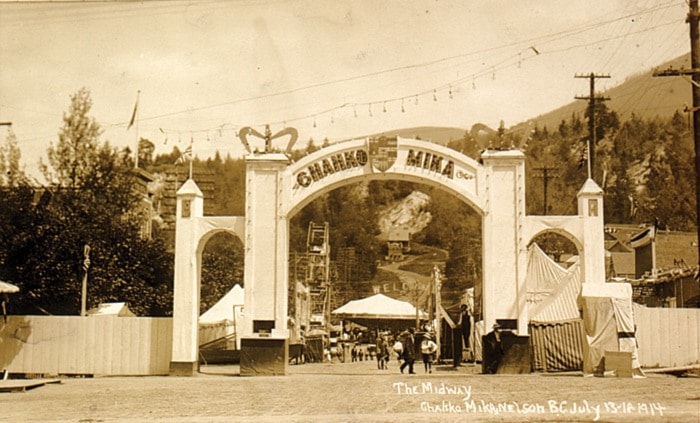Chinook jargon was a commonly-used pidgin trade language throughout B.C. and the Pacific Northwest in the 19th century, with a limited vocabulary and simple grammar that made it easy to learn. It borrowed from English, French, and a variety of First Nations languages, and some of its words remain in common use (skookum and potlatch, for example) while others appear on local maps.
Sitkum, Lebahdo, and Taghum
The three best known Chinook place names in West Kootenay all trace back to the same man: John C. Bell, Nelson’s mayor in 1925, and with A.G. Lambert, half of a partnership in several local sawmills. The evidence that Bell named these places is circumstantial: he had ties to each one, and none had been so named before he arrived.
Bell pre-empted land at Sitkum Creek on April 29, 1895. Sitkum means middle or half, which may reflect its position approximately halfway along the North Shore. (There’s another Sitkum Creek, as well as a Sitkum Lake, in the Monashees west of Upper Arrow Lake.)
In 1905, Lambert and Bell erected a mill in the Slocan Valley at a spot south of Winlaw known as Watson Siding. The following year, the name on the CPR timetable was changed to Lebahdo — the Chinook word for shingle, which was probably one of the mill’s chief products. The name survives on a misspelled street sign.
(It’s also interesting to note the similarity of Lebahdo to the Doukhobor suname Lebedow, which means swan. Although it has the same pronunciation, Lebahdo predated the Doukhobor migration to B.C.)
Two years later, Lambert and Bell moved their mill to Sproule Creek, a location that became known as Taghum — the Chinook word for six. Six what, however, is a bit of a mystery. Some sources suggest six miles from Nelson — but it’s actually less than five. Another says it meant six miles to the Nelson wharf, and yet another six miles to the Kootenay River falls.
(It seemed appropriate that the Taghum Trading Co., an antique store that operated there in recent years, took its name from a trading language.)
However, there’s nothing in Bell’s background to explain his knowledge of or fondness for Chinook jargon, nor did he take credit for the names.
One other place name that failed to stick was Wah-Wah Creek, today known as Kinney Creek, which flows into Pass Creek. Wawa is the Chinook word for speech.
Tillicum
The Tillicum Inn at Balfour was part of a resort Ken and Bobbi Chandler built in 1947. Tillicum is a Chinook word with all-round positive meanings: friends, relations, tribe, nation, common people. The resort’s coffee shop resembled a longhouse and featured totem poles on either side. It also had a gift shop, dining room, and three cabins.
According to Kootenay Outlet Reflections, the Chandlers operated the Tillicum until 1959, and then it went through several owners over the next decade before George LaPointe took over in 1970. He amalgamated it with the neighbouring Rainbow Resort.
There’s also a Tillicum Mountain northeast of Burton and a Tillicum Creek which flows into the Pend d’Oreille River near Remac.
Chahko Mika
When Nelson’s lakefront shopping mall was built in 1980, the name was chosen in a contest. Gladys White submitted the winning entry, a suggestion from her son-in-law Max Carne. Chahko Mika is Chinook for “you come,” or rather “come you.” In addition to being an unusual sounding name, it pays tribute to one of the city’s biggest celebrations.
In July 1914, Nelson was at its peak, and Chahko Mika was the equivalent of its World’s Fair: a parade, races, regatta, midway, and queens pageant, all packed into a week-long carnival. The name was also chosen by contest: Rex Cockle of Kaslo was credited with coming up with it.
Although reportedly a financial flop, the event was fondly remembered not only for its size, but due to its timing: within a few weeks of its conclusion, locals were leaving to fight in World War I. The fair was a final happy memory before the horrors of the next four years.
The Chahko Mika fair was resurrected for a while in the 1960s.
